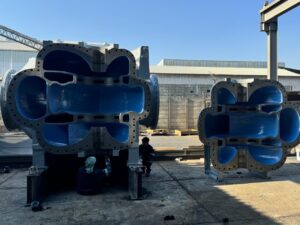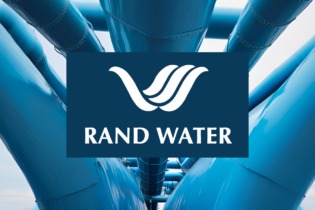A part of Rand Water’s proactive infrastructure maintenance project comprised the refurbishment of pumps and electrical boards at the Lethabo Intake Pumping Station. This key facility pumps water to ESKOM Lethabo Power Station and supplies over half of Gauteng via the Vereeniging Pumping Station.
The Lethabo Intake Pumping Station is owned by Rand Water and was constructed in 1982 under the Additional Water Supply (AWS) Scheme. It is the primary source of raw water supply to the Vereeniging Pumping Station and Eskom Lethabo Power Station. Approximately 1200 Mℓ/day of water is pumped through three centrifugal vertical split case 450 Mℓ/day pump-sets, with an extra standby pump (4 to 7). Raw water to the Eskom Lethabo Power Station is supplied through three 105 Mℓ/day pump-sets (1 to 3).40 years later
“All pumps at Lethabo are Mather + Platt that have been in operation since 1982. We were delighted to see that four decades later, besides the normal wear and tear, the pumps were still in good condition. Given our history with this pumping station, we were honoured to be awarded the contract for the overhaul and recommissioning of our pumps as well as the electrical, mechanical and civils works,” says John Montgomery, general manager for the APE Pumps and Mather+Platt Group. The Group holds an 8ME (mechanical and electrical) contractor grading per the Construction Industry Development Board’s ranking system. APE Pumps can therefore provide a full turnkey solution.“Most of our clients prefer one contractor to take responsibility for all the electrical and mechanical elements. This removes the ‘blame game’ where a valve supplier will blame a pump supplier who will blame an electrician who will blame the civils should something go wrong. As an original equipment manufacturer (OEM), we possess comprehensive knowledge of our systems and the appropriate technologies, engineering expertise, and manufacturing capabilities to refurbish and recommission any of our installed pumps,” he adds.This was reiterated by Moleboheng Nenzhelele, project manager, Rand Water: “Contracting an OEM to maintain and refurbish their own pumps drastically added to the success of the maintenance project. It gave us peace of mind as APE Pumps had the requisite knowledge to refurbish the pumps.” Included in the scope of works is the repair of the chamber’s concrete base, as well as the installation of new pipe flanges and pipe stands and the manufacture and installation of the blank flanges for when the pumps are removed for maintenance. APE Pumps had to remove (and reconnect once the pump was refurbished) all instrumentation and cable tray systems. Upon conclusion of the project, APE Pumps will provide as-built drawings to Rand Water that will give a detailed blueprint of the pumps, valves, electrical and instrumentation.
Removal of the pump
“This maintenance project was the result of extensive planning over several years, involving close collaboration between APE Pumps and Rand Water’s electrical, mechanical, operational, asset, quality, and safety teams. We strategically scheduled the work for June, when water demand is typically lower during the winter months, to minimise any potential impact on our customers,” states Nenzhelele. As one of the key pumping stations in the country, Lethabo must continue operating with no disruptions. Therefore, APE Pumps is refurbishing and then commissioning one pump at a time. It was decided that Pump Set 5 was most in need of refurbishment. There was excessive leaking due to wear of the stuffing box area and the pump was not performing optimally. Nenzhelele explains that a programme of works was drawn up where time frames and responsibilities were allocated to different parties. The 45-tonne pump was removed from its chamber in three pieces – top casing, rotating elements and bottom casing – by a specialist rigging contractor on the 4th July and will be recommissioned in early September. During the entire maintenance process, Pump Set 5 is insured for its full replacement value by APE Pumps. “The removal of this pump was the trickiest part of the entire maintenance project. This was because both Pump Set 4 and Pump Set 5 had to be turned off as they both run into the same manifold. There was also a risk of flooding the entire pumping station. The pumps were isolated using a bypass valve, suction valve and delivery valve as well as an actuator that stops the flow of water through the pumps. Another valve is opened to drain the line. When draining the line, there was mild flooding of the system. The pump that is used to cool the motor then tripped. Fortunately, APE was able to replace that pump on the same day and the system was not compromised,” says Montgomery. Work was done on a discharge valve, and each pump now has its own manifold. Going forward, only one pump set will have to be shutdown at a time for any future maintenance work. `Drawings and 3D Scanning
The OEM keeps technical drawings for every single pump ever produced since 1952 in a vault system. These technical drawings can be used to execute assessments, repairs, refurbishments or a complete rebuild. The drawings contain details like metallurgical materials, type of liquid handled, casing and impeller trims. Drawings for the pumps at the Lethabo Intake Pumping Station were available and used to bring Pump Set 5 back to OEM status with the correct size brackets and bearings.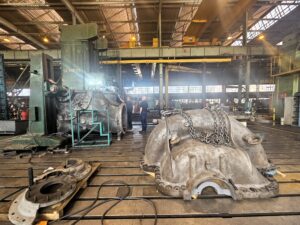 “An important part of the pump refurbishment was bringing the pump back to OEM standards by removing all non-OEM parts. Pirated parts do not precisely match APE Pumps and Mather+Platt design tolerances and are therefore prone to premature failure. They expose the pump to the risk of cavitation, as well as imminent bearing, impeller, wear ring and shaft failures,” explains Montgomery.
“An important part of the pump refurbishment was bringing the pump back to OEM standards by removing all non-OEM parts. Pirated parts do not precisely match APE Pumps and Mather+Platt design tolerances and are therefore prone to premature failure. They expose the pump to the risk of cavitation, as well as imminent bearing, impeller, wear ring and shaft failures,” explains Montgomery.The drawings were complemented with APE Pump’s latest 3D scanning technology, which achieves a 0.02 mm-dimensional accuracy. All pump parts (new and old) are scanned to confirm that they either meet the specifications of the manufacturing drawings or are feasible to reuse. These pumps can be scanned at the APE premises or on-site. The pump had to be scanned by two teams and two separate scanners because of the size of the pump, this enabled A.P.E Pumps to manufacture a like for like pump if needs be in the future without removing one of the existing pumps for reference.
“The 3D scanner has drastically increased our turn-around time for pump repairs and retrofits. With this data, we were able to manufacture some of the internal components of the pump as well as the pipe stands, prior to the pump coming out,” says Montgomery. The company is busy scanning all the pumping stations around the country that are fitted with APE Pumps. “We are able to extract valuable information from these 3D scans, from the colour of cabling to the size of a bolt or length of the pump without sending someone onto the site,” he adds.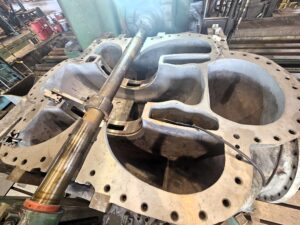 According to Thorne Zurfluh, a mechanical engineer at APE Pumps, one of the biggest benefits of 3D scanning is quality control.
“At APE, 3D scanning is used over and above the traditional quality control methods. It is an additional aid to prevent the misalignment of pumps by verifying pump geometries (concentricity, parallelism, perpendicularity and shaft runouts) during manufacturing, assembly and even commissioning. All pump parts are scanned to confirm that they meet the specifications of the manufacturing drawings. The 3D scans also generate digital reports indicating that the pump and pump parts meet (or do not meet) certain specifications and tolerances. These reports are often supplied to customers.”
According to Thorne Zurfluh, a mechanical engineer at APE Pumps, one of the biggest benefits of 3D scanning is quality control.
“At APE, 3D scanning is used over and above the traditional quality control methods. It is an additional aid to prevent the misalignment of pumps by verifying pump geometries (concentricity, parallelism, perpendicularity and shaft runouts) during manufacturing, assembly and even commissioning. All pump parts are scanned to confirm that they meet the specifications of the manufacturing drawings. The 3D scans also generate digital reports indicating that the pump and pump parts meet (or do not meet) certain specifications and tolerances. These reports are often supplied to customers.”
World class water board
Montgomery adds that Rand Water were well prepared for the maintenance work. “Firstly, they had a spare motor for redundancy, they also had the rotating elements and bearings manufactured and ready for the pump maintenance work before the pump was removed. The original bearings took close to seven months to be manufactured and delivered from the United Kingdom,” explains Montgomery. Furthermore, Rand Water have excellent governance systems in place. They have their own quantity surveyor, quality control department and project manager. An audit process in instituted once anyone signs off on the manufacture of a pump part. Auditors will check that the pump part has been manufactured and is to the correct quality. There are stringent quality control plans that are meticulously followed. “Rand Water is a responsible institution, they have an entire team that evaluates the performance of pumps, and we will only be required to do work on pumps that are not performing optimally,” adds Montgomery. Most of the internal components of the pump have been replaced. APE Pumps themselves have conducted extensive quality tests such as dimensional checks, paint thicknesses, clearances on the bearings, balancing, material certifications as well as dye penetrant (DP) inspection on the impellers. Representatives from Rand Water are sometimes present at these quality checks.Maintenance
Additional maintenance work included shot blasting the pump casing to remove shells and freshwater mussels as well as lasering to remove the salt from the steel. The pump will be recoated and sealed, covering any pit holes. Line boring was done to restore the old pump casings for an efficient pump operation. This requires a high level of precision as the tolerances are extremely small. By definition, line boring is a machining operation of a cylindrical hole effected by a machine tool called line boring machine. The operation consists into enlarging the hole to reach the desired diameter or to correct its axiality. The weep holes of the pump had to be rebuilt to make them concentric.
There is no gasket between the pump casings – the machined smooth finish makes the casings watertight.
“We sourced an artisan with decades of experience and found one of the few line-boring machines (18 metres long) on the continent that could work on pump casings of this size,” states Montgomery.
Line boring was done to restore the old pump casings for an efficient pump operation. This requires a high level of precision as the tolerances are extremely small. By definition, line boring is a machining operation of a cylindrical hole effected by a machine tool called line boring machine. The operation consists into enlarging the hole to reach the desired diameter or to correct its axiality. The weep holes of the pump had to be rebuilt to make them concentric.
There is no gasket between the pump casings – the machined smooth finish makes the casings watertight.
“We sourced an artisan with decades of experience and found one of the few line-boring machines (18 metres long) on the continent that could work on pump casings of this size,” states Montgomery.
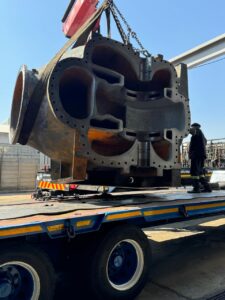 Through Mather+Platt, the relationship between APE Pumps and Rand Water began in 1919, when they supplied a steam turbine pump.
“As a South African company, APE Pumps supplies water boards and electricity suppliers across the country. This is because firstly, we have been in operation for 72 years, plus, we are part of the global WPIL Group in India with extensive backing and leverage from our sister OEMs in regions that include Australia, the United Kingdom, Thailand and Italy. We are constantly investing in our company through buying new equipment, adopting the latest technology and training our staff. To the best of our knowledge, few pump companies match our local capacity,” Montgomery concludes.
Read more: https://issuu.com/infrastructurenews/docs/wasa_july_august_2024
Through Mather+Platt, the relationship between APE Pumps and Rand Water began in 1919, when they supplied a steam turbine pump.
“As a South African company, APE Pumps supplies water boards and electricity suppliers across the country. This is because firstly, we have been in operation for 72 years, plus, we are part of the global WPIL Group in India with extensive backing and leverage from our sister OEMs in regions that include Australia, the United Kingdom, Thailand and Italy. We are constantly investing in our company through buying new equipment, adopting the latest technology and training our staff. To the best of our knowledge, few pump companies match our local capacity,” Montgomery concludes.
Read more: https://issuu.com/infrastructurenews/docs/wasa_july_august_2024


